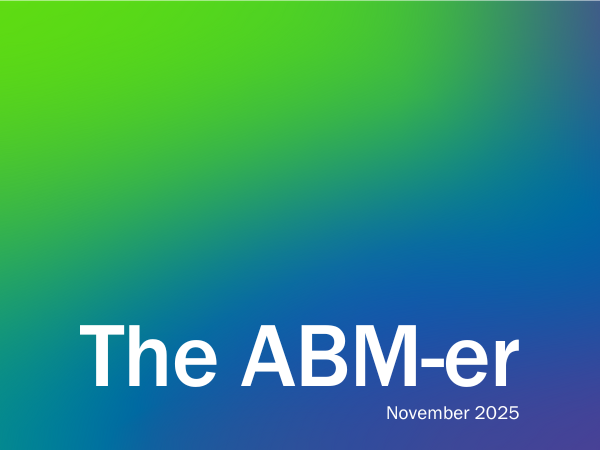Any quality building project starts with a plan and a foundation. Same for account-based marketing (ABM) programs. What’s very different between a building project and a marketing program is how complete the plan and foundation need to be before we start, and how much it will need to change before we’re finished (if we in marketing ever can really consider something “finished”).
Inflexion Group’s AI in ABM 2025 Benchmarking Study highlights not only the changes ABM-es are making to their plans based on AI, but also how fast it’s happening. We’re adjusting plans, redesigning what to build, and adapting foundations to embrace the potential of AI and support the needs of a changed buyer journey. The data also suggests that, while we’re still figuring out what the end state might be, we like our options, and some builds are much further along the path to impact than others.
Note: Last week, my colleague Dorothea Gosling shared overall highlights from this research and her observations from the recent Global ABM conference (link to post in comments). This week, I’m sharing study findings about how companies are developing their AI foundations. Each week, we’ll share additional insights from the study to help with your own AI in ABM efforts.
Why companies are adopting AI
When we consider what is most different and difficult about ABM, most would place gathering and acting upon timely customer insights at the top of the list. No surprise that’s the first place our study shows ABM-ers looking for AI to help. In fact, all the top reasons companies are adopting AI for AI come from a desire for AI to help with what most teams don’t have in program budget and people.
The top three drivers of AI adoption for more than half of study respondents include:
- Need for account insights and intelligence (71%)
- Demand for hyper-personalization at scale (61%)
- Need to scale strategic impact without growing headcount (59%)
What’s interesting, and essential to watch, are the three items that ranked lowest as drivers of AI adoption:
- Customer expectations for intelligent engagement (16%)
- Competitors gaining advantage through AI adoption (16%)
- Market pressure for predictive capabilities (4%)
Top drivers for AI adoption
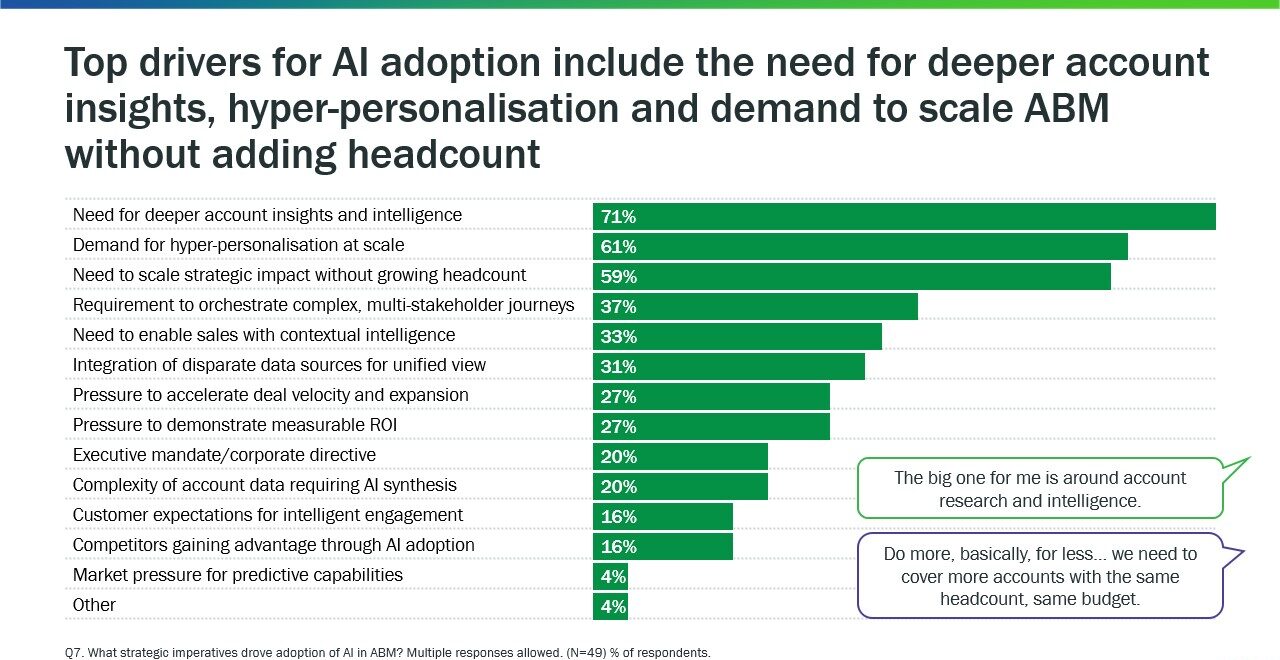 Source: Inflexion Group AI in ABM Benchmarking Study 2025
Source: Inflexion Group AI in ABM Benchmarking Study 2025
The speed with which companies adopt AI, and the growing lead early adopters have gained, means customer expectations are changing, too. AI makes it easy for any size team to deliver the basics of competent segmentation, personalization and content. That raises the bar to stand out, and ABM teams will feel this pressure. Now, general demand generation and outbound sales efforts look like what simple programmatic and segment ABM worked hard to deliver only a year or so ago. ABM-ers will have to do better for their work to break through the clutter of competent but uninspiring marketing. The foundation they build now needs to hold up as pressure from declining organic search volume and lower response rates to traditional outbound are increasingly the norm in B2B buying.
AI adoption is still in its infancy
While it feels like AI is everywhere, the reality is that it hasn’t been mainstream for very long. Adoption rates remind us that enterprise-level AI deployment is still very new to a lot of ABM teams. Our study found that 53% of companies have been using it less than one year, and there are still 10% who aren’t using AI at all (yet). This corresponds to our finding that 43% of companies consider themselves to be experimenting with AI, and the 13% who are still planning.
At the same time, that means nearly half of companies have been using AI for more than a year. In fact, 24% said they’ve been using AI for 1 to 2 years, and 10% reported they’ve had in in place for more than three years. Even with this timing advantage, it’s still clear that we’re in the early days of the AI wave because just 2% of these companies call themselves advanced in their efforts.
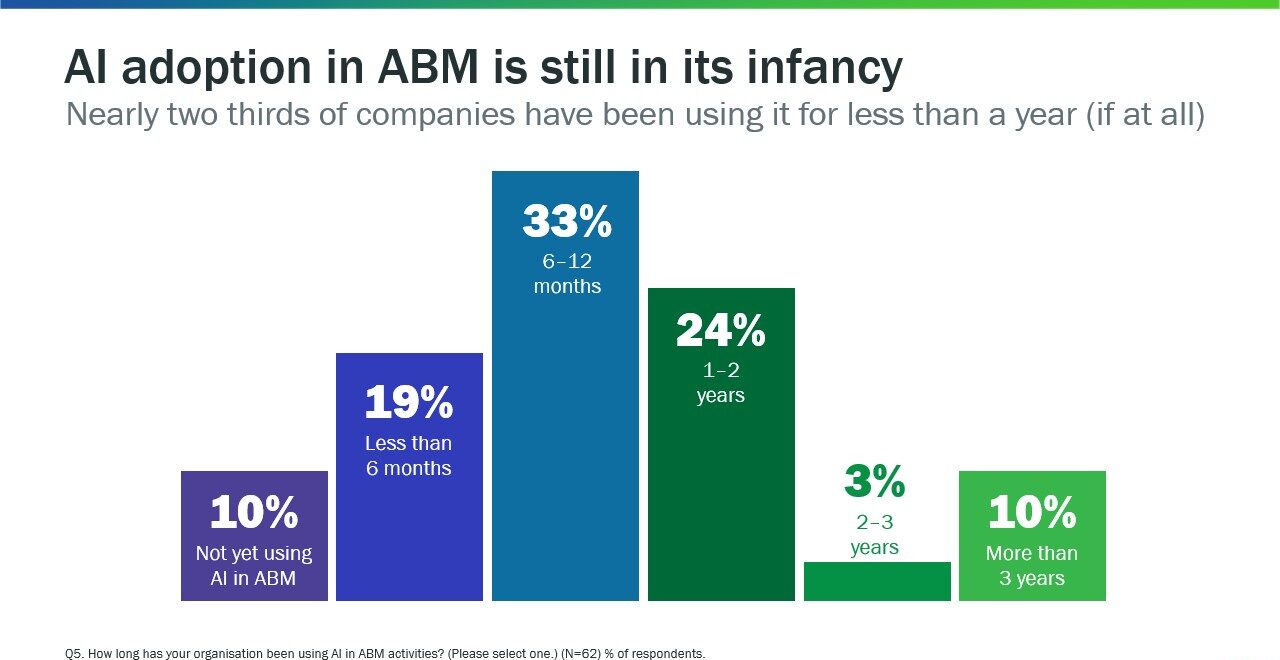 Source: Inflexion Group AI in ABM Benchmarking Study 2025
Source: Inflexion Group AI in ABM Benchmarking Study 2025
Consider the foundational advantage these companies in terms of readiness as AI evolves and matures for ABM. The 38% of companies who consider themselves at the point of establishing or scaling their ABM efforts in our study have learned what delivers the most value given the current state of the art. Their early learning can help other ABM-ers accelerate time to impact by paying attention the foundational elements and use cases these teams find most valuable and skip over the rest. They can also help set realistic expectations for return-on-investment (ROI).
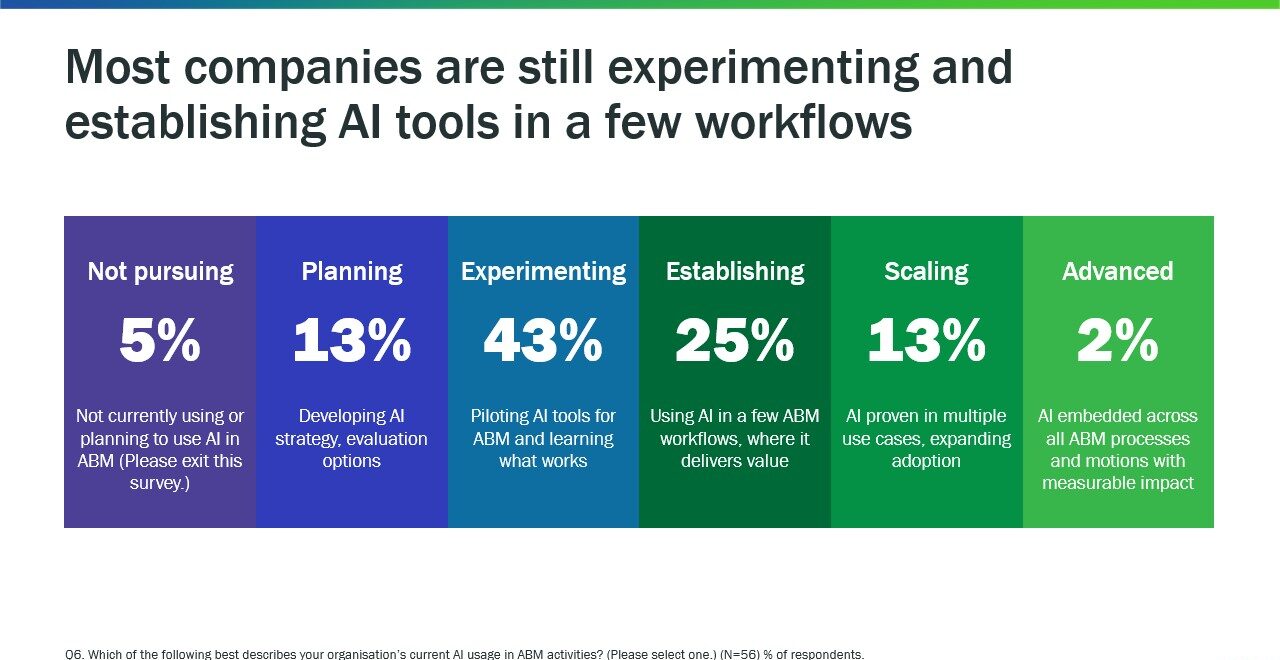 Source: Inflexion Group AI in ABM Benchmarking Study 2025
Source: Inflexion Group AI in ABM Benchmarking Study 2025
Foundations for Agentic AI in ABM
ABM-ers are deploying AI agents as part of their AI foundation. Our study showed that 30% of companies are testing (23%) or actively using (7%) agents effectively in their ABM processes. Another 23% are planning implementation within 12 months. Agents are how ABM-ers address more complex workflows and scale productivity. They hold great potential as an answer to some of the challenges ABM-ers said they AI to address, including the 38% looking to AI to help with orchestrating complex, multi-stakeholder journeys. Agents are ideal for efforts to integrate disparate data sources into a unified view (31% want AI to help here), and to accelerate deal velocity and expansion (27%).
Again, early adopters are demonstrating what’s needed for agents to deliver ROI. Teams among the 30% who told us they are interested in agents but still cautious or sceptical are getting a preview of what they may want to build. While they’ll be slower to see the rewards, they may have an easier time winning budget and resources in risk-averse organizations.
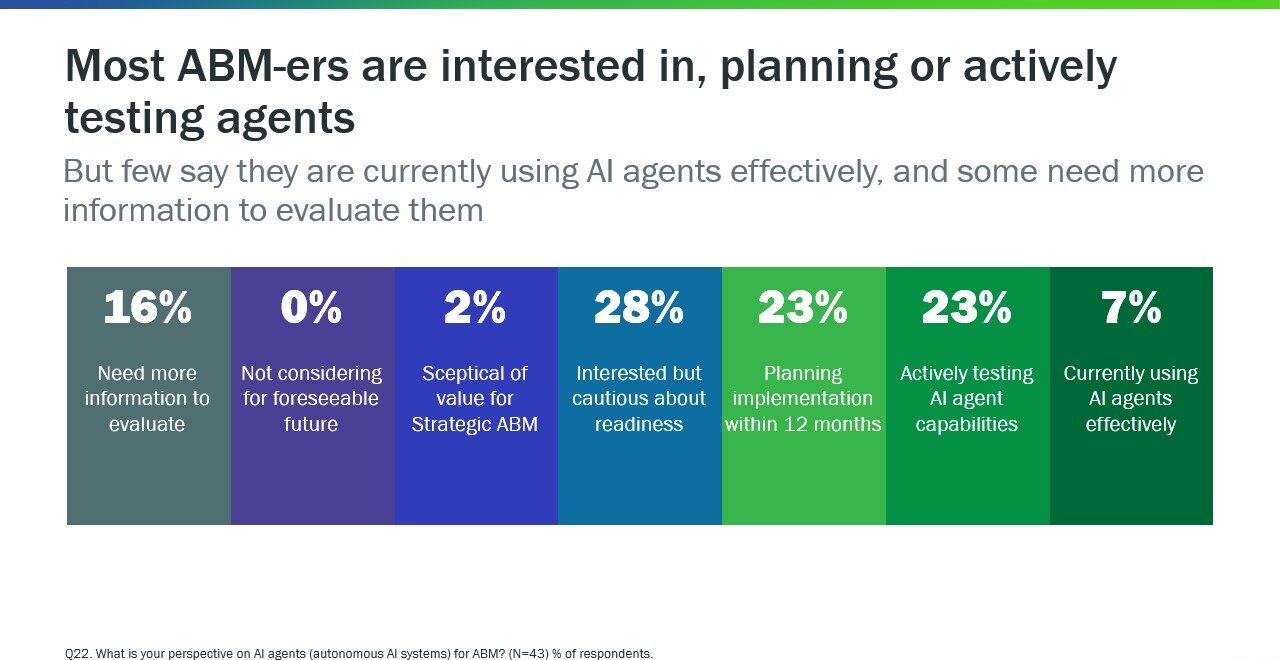 Source: Inflexion Group AI in ABM Benchmarking Study 2025
Source: Inflexion Group AI in ABM Benchmarking Study 2025
Advice for peers building ABM AI foundations
Our study included both quantitative and qualitative findings, including detailed interviews with ABM leaders working with AI. They shared important guidance for those developing the foundation for AI.
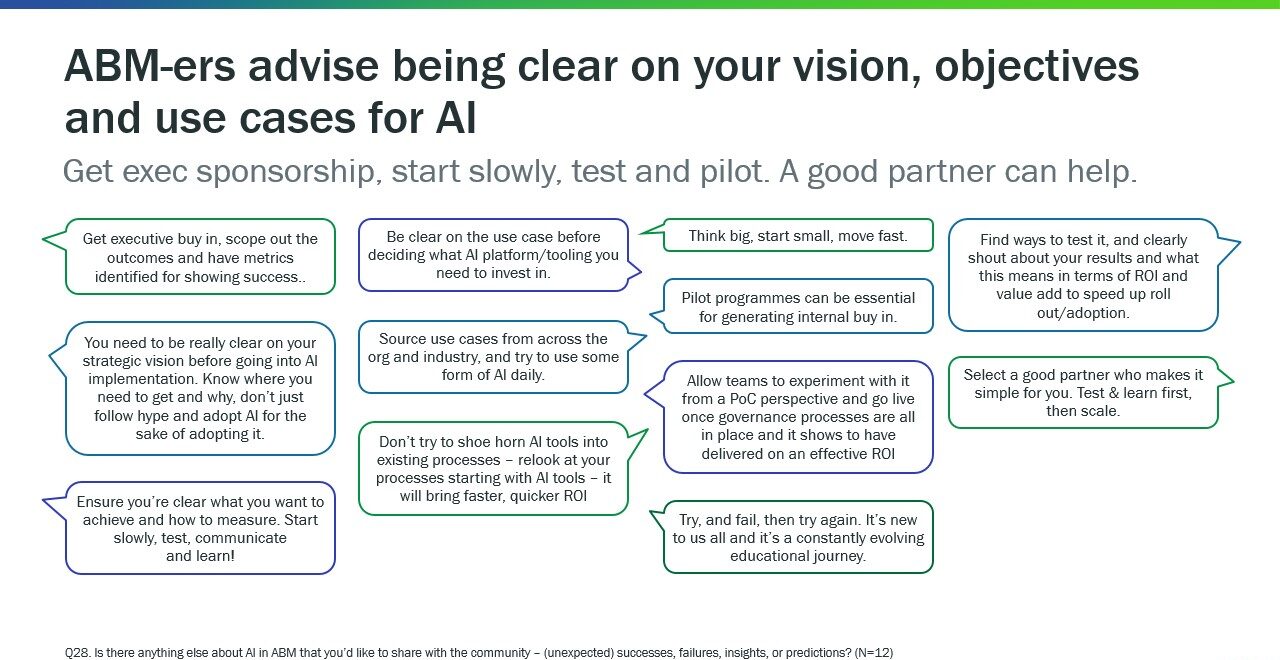 Source: Inflexion Group AI in ABM Benchmarking Study 2025
Source: Inflexion Group AI in ABM Benchmarking Study 2025
Just as with a building’s foundation, what you need depends very much on what you want in the end. Our study participants point to the need for a clear vision and goals for ABM, tempered with a realistic understanding of what is possible with AI today. They also advised putting metrics in place early, so AI deployment has a clear path to business impact.
At the same time, many also noted speed and flexibility are critical. With a market and technology changing as fast as AI is right now, the “perfect” plan will be outdated before anything is built. Pilot programs and other ways to test AI readiness and impact ensure your foundation is built to last long enough to support rapid adoption cycles. As one respondent said so well, “think big, start small, move fast.”
How AI adoption is helping ABM teams today
What’s the promise of AI when it comes to teams who may be nervous about deploying a technology that could significantly change their roles or, at worst, make their roles unnecessary? Companies in our study building the foundations for AI focused on its potential to make jobs better, not eliminate them.
Related to the need for deeper insights as the top driver of AI adoption we found, ABM-ers told us the main benefit of AI for their teams is the ability to provide deeper insights and advisory capabilities (61%). That foundation of better insights is delivering other benefits, including being able to spend more time on strategy and less on execution (47%), and elevating their position as strategic leaders (20%). Our experience has been that in general ABM-ers bring more strategic perspective and experience to their roles. It’s good news that AI is freeing them to step into their potential for greater focus on being creative and building relationships (20%).
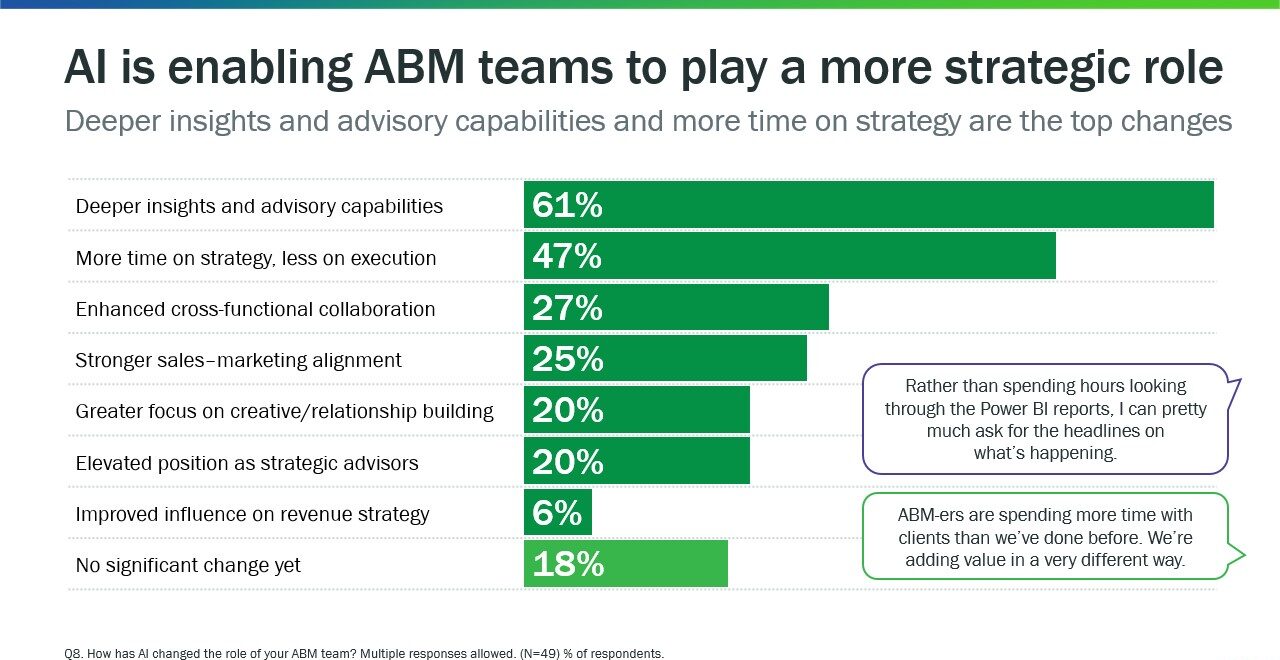 Source: Inflexion Group AI in ABM Benchmarking Study 2025
Source: Inflexion Group AI in ABM Benchmarking Study 2025
Other bright spots from our findings are that AI is bringing sales and marketing into closer alignment (25%) and enhancing cross-functional collaboration (27%). ABM impact depends on sales and marketing working effectively together, and both teams are under pressure in many companies to deploy AI and deliver revenue impact. Given the relatively short time AI has been in place for many of our study respondents, it’s no surprise that just 6% have seen improved influence on revenue, and 18% haven’t seen a change from their AI efforts. Our findings suggest the positive view of AI’s role in other areas means ABM teams are building a solid foundation that will support greater impact as deployment scales and matures.
What’s next in the series
In the coming weeks, my colleague Dorothea Gosling and I will continue to unpack study findings in detail. Next week, I’ll share what the data said about the implementation approaches ABM-ers are taking. Don’t miss the first post in the series, where Dorothea summarizes the study findings and shares highlights from her presentation and workshop on AI at the recent Global ABM conference (link in comments).
About the 2025 AI in ABM Benchmarking Study
The 2025 Inflexion Group AI in ABM benchmarking study looks at how ABM professionals are integrating artificial intelligence (traditional, generative and agentic) into their daily workflows, and whether those efforts are creating measurable business value. It included two phases of research. The first was 20 in-depth interviews with global ABM programme leaders during August and September 2025. The second was a quantitative study in partnership with B2B Marketing where we invited ABM-ers to complete an online survey during September and October. A total of 66 people participated. Just over 50% of respondents were from global, enterprise-level companies with more than 5,000 employees and the rest were from companies ranging from those with fewer than 200 employees (23%) and from 201 to 1,001 employees (26%).


